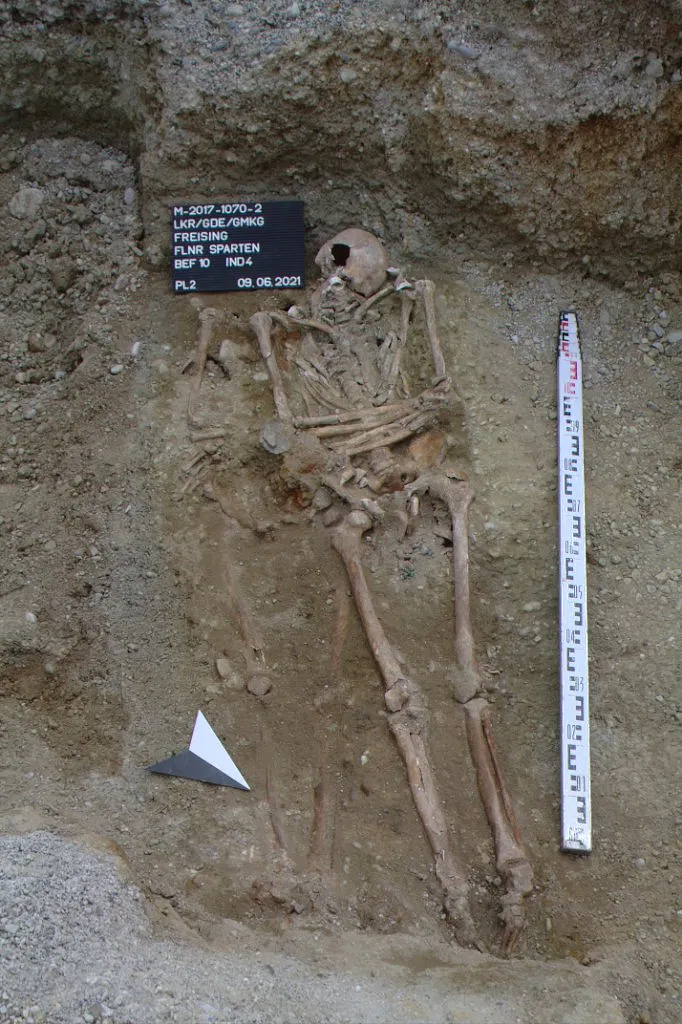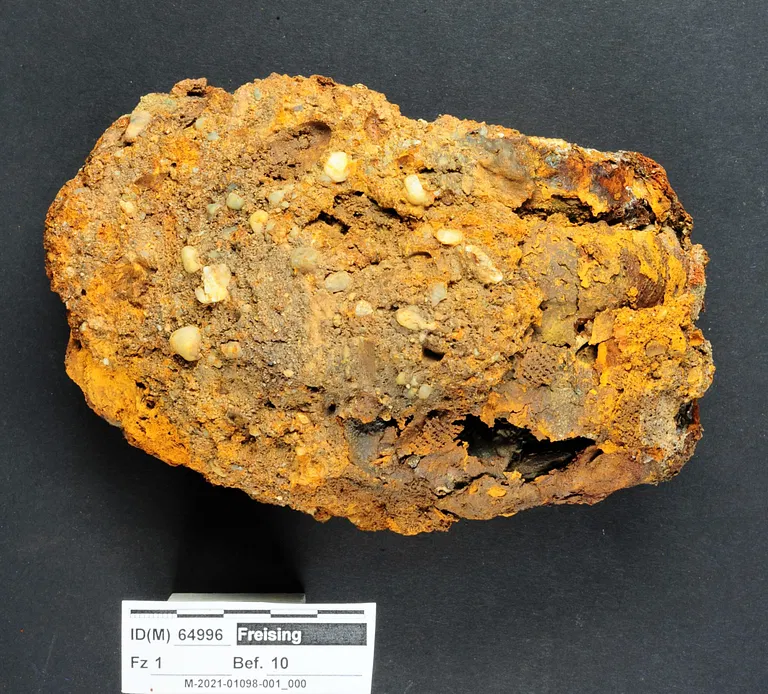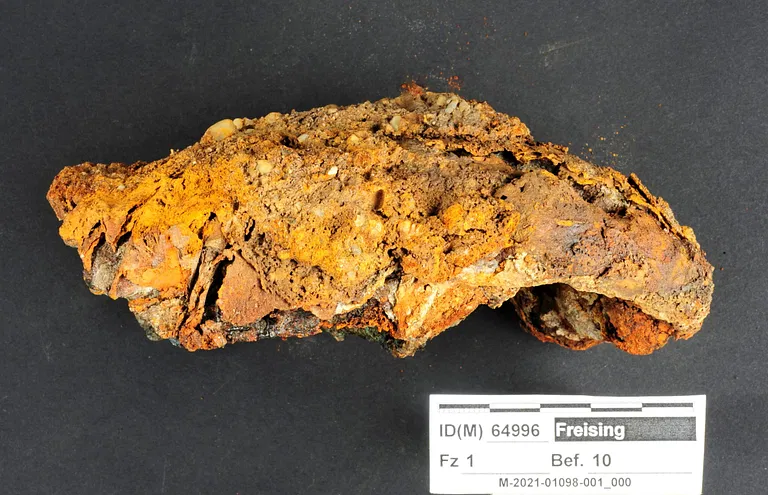You are using an out of date browser. It may not display this or other websites correctly.
You should upgrade or use an alternative browser.
You should upgrade or use an alternative browser.
nivek
As Above So Below
View: https://www.youtube.com/watch?v=7875sUaZmzY
'Pet' Deer Wearing Collar Seen Wandering Around Missouri Neighborhood
Wildlife officials in Missouri responded to a rather unusual call this past week when someone spotted a deer wandering around a neighborhood with the word 'pet' painted on its side and wearing a collar. The strange case was reportedly revealed this past Sunday when the Jefferson County Sheriff's Office shared a jaw-dropping picture of the oddly marked animal on their Facebook page and explained that it had been seen in the rural community of Festus in late September. They went on to stress to residents that "wild animals should not be considered pets and particularly deer should not be moved from their habitat."Although the Facebook post did not indicate how the animal might have wound up in such a state nor what became of it after officers from the state's Department of Conservation responded to the call, residents were understandably intrigued by both questions and, fortunately, answers soon followed. Conservation official Scott Corley speculated to a local media outlet that "somebody most likely took that deer out of the wild as a fawn and tried to keep it as a pet and put a collar on it." As for why the word 'pet' was painted on its side, the prevailing theory is that the misguided label was an attempt to protect the creature with hunting season set to commence soon.
Where the 'domesticated' deer is currently located is more of a mystery as the animal was nowhere to be found when conservation officers responded to the initial call. That said, a safe bet is that it is probably still wandering around Festus as residents of one specific neighborhood told a local TV station that they have seen the unnaturally tame animal in their backyards for the last few months and that its complete lack of fear for human left them rather unsettled. In a tragic twist to the weird tale, whoever befriended the deer and decided to domesticate it may have actually spelled its doom as authorities are now on the hunt for the collared creature and, if they find it, could wind up euthanizing it out of fear that it cannot be safely returned to the wild.
.
pigfarmer
tall, thin, irritable
I had to go back and take another look at that DeLorean barn find. From what I understand, when new those things were pigs incapable of getting out of their own way. I remember one for sale years ago around here for $5K and nobody would touch it ! A neighbor had a Bricklin SV-1 and that scored more waaaaay cool points. Bricklins were plastic two person buckets with respectable V8s and those same gull wing doors. I think they were on par with the same questionable quality control that DeLoreans had, meaning that the damned things didn't fit together very well. If one of those things had a 1.21 GW Flux Capacitor and a Ford 351 Windsor then getting to 88mph would have been a whole lot simpler and we'd be in love with them instead 
Reminded me of Christie's Star Trek 40th Anniversary auction where I got to see the original series props and costumes in regular lighting up real close. What crap ! Our imaginations did far more than you might... well ... imagine. Same for DeLoreans I think.
In the article it said sun damage and rodents were two huge factors. Yup, I can attest. The dash, center console, vents and entire AC system in the 'vette was literally packed full of rodent bones, desiccated carcasses, nesting, poop, nuts and they remnants of whatever they chewed the hell out of. At least it was in somebody's garage. That old Saab literally sat in the dark a great portion of it's life. The dash and pad are in perfect condition, no cracks, the interior isn't even faded. It's a real time capsule. It hasn't run in a couple of weeks, waiting on parts, and I've noticed chipmunks hanging around it.
If I have to lay out there in a ghillie suit and take those little furry bastards out one by one I will. It's a test of wills and Ultimate Victory is mine ! Swine rodents.
Reminded me of Christie's Star Trek 40th Anniversary auction where I got to see the original series props and costumes in regular lighting up real close. What crap ! Our imaginations did far more than you might... well ... imagine. Same for DeLoreans I think.
In the article it said sun damage and rodents were two huge factors. Yup, I can attest. The dash, center console, vents and entire AC system in the 'vette was literally packed full of rodent bones, desiccated carcasses, nesting, poop, nuts and they remnants of whatever they chewed the hell out of. At least it was in somebody's garage. That old Saab literally sat in the dark a great portion of it's life. The dash and pad are in perfect condition, no cracks, the interior isn't even faded. It's a real time capsule. It hasn't run in a couple of weeks, waiting on parts, and I've noticed chipmunks hanging around it.
If I have to lay out there in a ghillie suit and take those little furry bastards out one by one I will. It's a test of wills and Ultimate Victory is mine ! Swine rodents.
nivek
As Above So Below
Strange methane leak discovered at the deepest point of the Baltic Sea baffling scientists
A huge methane leak discovered in the Baltic Sea spans 7.7 square miles, with masses of gas bubbles rising almost all the way to the ocean surface. The vast methane leak has been discovered at the deepest point in the Baltic Sea, and masses of bubbles of the greenhouse gas are rising far higher into the water column than scientists had expected.Researchers found the enormous leak 1,300 feet (400 meters) beneath the water's surface during an expedition to the Landsort Deep — the Baltic's deepest spot — in August. The area leaking methane is roughly 7.7 square miles (20 square kilometers), equivalent to about 4,000 soccer fields.
"It's bubbling everywhere, basically, in these 20 square kilometers," Marcelo Ketzer, professor of environmental science at Linnaeus University in Sweden and project leader, told Live Science.
In shallower, coastal seabeds, methane bubbles up from decaying organic matter, while in deeper water, it tends to disperse via diffusion — meaning no bubbles are needed — and most of the diffuse methane remains in the deepest water. But the new leak doesn't follow this pattern.
"By discovering this [leak], we realized that there's a totally different mechanism supplying methane to the bottom of the Baltic," Ketzer said.
The team was also stunned to observe how far the methane bubbles rose in the water column toward the sea surface. Methane usually dissolves in water, so as bubbles rise, they decrease in size until there's nothing left. Ketzer said the maximum height they would expect methane bubbles to reach was around 165 feet (50 meters) from the ocean floor. Yet at the Landsort Deep, the team observed methane bubbles reaching 1,250 feet (380 m) into the water column — just 65 feet (20 m) from the surface.
"So that's completely new," Ketzer said.

Sonar image showing the methane bubbles rising from the ocean floor through the water column in the Baltic. (Image credit: Christian Stranne)
He believes this is due — at least in part — to a weaker than average microbial filter, a layer of bacteria that live in sediments and "eat" up to 90% of the methane produced by decaying matter. This filter can be several feet thick in the ocean, but in the Baltic Sea, it is a few centimeters thick, Ketzer said.
Human activity is also altering the way this filter operates, according to Kretzer.
Fertilizers from land that reach the sea boost algae blooms. When the algae die, they add organic matter to sediments. The methane-eating bacteria also like to munch on this material, enabling more methane to escape toward the surface. Furthermore, the researchers think the Landsort Deep leak may be caused by large amounts of sediment deposited there by bottom currents.
"How much we are responsible for weakening this filter and allowing more methane to pass is something that we don't know, but it's something that we'd like to investigate," said Ketzer. In addition, water at the bottom of the Baltic contains high levels of methane, so the bubbles may have to travel higher in the water column to dissolve — although this doesn't fully explain how they are getting so close to the surface.
Ketzer's team is preparing a second expedition to the Landsort Deep to find out if any bubbles make it to the surface and release methane into the atmosphere. Methane leaks like this are potentially important sources of greenhouse gas that scientists need to account for. Ketzer estimates there could be half a dozen other deep sea methane fields bubbling away in the Baltic.
"We are continuing to find new locations where seepage is occurring, Anna Michel, associate scientist at the Woods Hole Oceanographic Institution, who was not involved in the project, told Live Science in an email. "It will be interesting to see if exploration of other parts of the Baltic Sea reveals additional sites of methane seepage."
.
nivek
As Above So Below
nivek
As Above So Below
Concord School Custodian Investigated For Dressing As A Horror Clown - A Broken Ground Elementary School employee remains on the job after teachers, others raised concerns about violent imagery, comments online.

An elementary school custodian for the Concord School District, who dresses as a horror clown, has been investigated and will remain on the job despite concerns raised by educators and other employees about the misuse of district property and comments and pictures he made for an online contest. Kathleen Murphy, the superintendent of SAU 8, confirmed there was an investigation of the Broken Ground Elementary School employee who had pictures of himself roaming through the building during his overnight work hours, dressed in a horror clown costume, and comments he made online for a clown contest with a prize of $13,000.
The custodian began promoting the contest in late August and early September, leaving sticky notes asking for staff support. Educators informed another custodian about the notes and found pictures of the custodian, dressed in his killer clown outfit, in different settings inside the school, including a hallway and a music room. The custodian did not pay to rent out the school for personal use.
More concerning, though, were comments made by the employee online. In an interview connected to the contest, the custodian was asked which movie monster he related to. He called it a hard question because “I see myself reflected in many movie monsters but for many reasons.” He then pointed to Jason Vorhees, the killer in the “Friday the 13th” series. “(He) was one for being singled out and hurt by those around me due to my differences leading to moments of anger, rage, and what I see as self-defense,” he reportedly stated.
The custodian also mentioned Frankenstein’s monster, saying, “I never asked to be made the way I am and most (of) my life has been pain and rejection done against me by the mad scientist that made me…broken.” The custodian said he has been working on indie films and the money for the contest could be used toward finishing his vision and dream as well as family expenses.
Another custodian for the district raised the issue with the central office, which led to the investigation. The complainant said they were concerned about the online comments and the violent nature of the custodian’s clown costume in an elementary school. He said word spread quickly throughout the school, and they were “very uncomfortable” about the situation. The entire situation may everyone feel “yucky” about the entire thing. After the investigation, the clown custodian remained employed.
The complainant said he and others became more frustrated as the clown custodian continued to post photos of himself while wearing Concord School District apparel — while also holding weapons, according to pictures from social media sites. Another report was filed, but nothing was done, he said. He added SAU 8 policy was to “know and tell” — reporting strange, unorthodox behavior or situations so they could be remedied and students and teachers could be kept safe. He said some educators would not stay late at the school because they did not feel safe.
“This is something I will not let slide, and I will do everything in my power to protect the staff and kids in my building,” he said. “I would never be able to live with myself if any staff or kids were ever harmed in any way, shape, or form.”
The complainant custodian, who had been working in the district for about eight years, said he had seen “many things covered up or not brought to the public's attention,” and it was time, in this case, to “take a stand and voice my concerns not only as an employee but a father to a wonderful girl who’s currently in elementary (school). That’s why this issue really hits home.” Murphy did not comment further about the case because it was a personnel issue. Not long after the investigation was closed and Patch learned about the situation, the clown custodian requested an article about the contest. Patch countered with several questions about concerns raised by educators and employees at the school and requested a response. The custodian, however, did not respond to the questions.
.
pigfarmer
tall, thin, irritable
Cold weather could have helped cause the Salem Witch Trials
Angeli Gabriel, FOX Weather
Published Oct. 31, 2023, 12:02 a.m. ET
The Salem witch trials were the largest witchcraft outbreak in American history, resulting from a perfect storm of catastrophes.
Taking place in 1692 and 1693, the Salem witch trials were held in towns across northeastern Massachusetts. The center of the trials was Salem Village, or the modern day town of Danvers, according to Salem State University history professor and author of “A Storm of Witchcraft” Emerson Baker.
More than 150 people were tried during the Salem witch trials, Baker said. Most were locked up in jail for months, and some were sentenced to up to a year or more. Five died in jail, 19 were executed, and one was pressed to death.
Baker noted that the witch hunt phenomenon was a regional crisis, and one that was caused by a perfect storm of factors.
One reason, particularly in Salem Village, was strife and factionalism as arguments over who the ministers should be, pitting neighbors against one another. Baker noted that this contention in the community laid the groundwork for accusations of witchcraft. In fact, the first people who were accused were the daughter and niece of a reverend who had political enemies.
Additionally, the people in the Salem area worried they were losing their Puritan mission. Most people came to Massachusetts to create their own community where they could worship their own faith. By the 1690s, however, Baker said many people felt that they’d lost that original fervor.
The people of Massachusetts were also concerned about a war they were fighting on the northern frontier, or what is now New Hampshire and Maine, according to Baker. They were battling the Native Americans and their French allies and losing.

Circa 1692, The trial of George Jacobs for witchcraft at the Essex Institute in Salem, Massachusetts.Getty Images
This was of particular concern for the people of 17th-century New England, as they were a largely agrarian society. Their communities were predominantly made of farmers or people who depended on their gardens to feed their families. So when bad weather struck, it led to crop failures, often starvation, disease and death.
Such a devastating weather pattern was caused by something much larger and more widespread than what the people of Salem might have guessed.
“As it turns out, the Salem witch trials took place in what we now recognize as the Little Ice Age, which was a time of colder climate, more severe weather,” Baker said.

Martha Corey and her prosecutors, Salem, Massachusetts, in 1692.Getty Images
He noted that the Little Ice Age lasted from about 1400 to 1800, and it caused temperatures to become considerably cooler. According to Encyclopedia Britannica, the temperatures across the Northern Hemisphere during the Little Ice Age dropped by 1.1 degrees Fahrenheit, or 0.6 degrees Celsius, and caused mountain glaciers to expand.
In addition to the drop in temperature, the Little Ice Age brought with it more storms and instability, Baker said.
The Little Ice Age brought cold winters with heavy snowfall; during spring, when farmers would plant their crops, frosts would come in until June. Summers were not much better for replanting; the weather was hot and dry enough to destroy more crops before another frost hit in August and early September.

When bad weather struck, it led to crop failures, often starvation, disease and death.Getty Images/iStockphoto
“It turns out the 1680s and the 1690s were the absolute most extreme weather of this whole Little Ice Age,” Baker said. “This was really extreme weather on an unprecedented scale, and it had consequences.”
The severe weather, in addition to war on the frontier, led many Puritans to believe that God was angry at New England for losing its spiritual community. In an attempt to find someone to blame, they held their witch trials.
Baker noted that people in the 17th century sometimes blamed bad weather on witches.
“If a bad storm at sea sank a ship, or if lightening struck and destroyed a house, or if a storm destroyed crops, they often felt a witch might have been responsible,” he said.
However, the trials did not lead to better days for the people of Salem and around New England. According to Baker, matters deteriorated for the next several years to the point where they realized the grave mistake they had made with the witch trials.
In 1697, Massachusetts called for a public day of humiliation and fasting. Baker said the occasion involved the colony publicly confessing its sins on how the colony had gone wrong, including being deluded by Satan to execute people for witchcraft.
“It wasn’t sort of a full apology, shall we say, but it was as close as the government could come at that point to acknowledging that it might not have been a great thing to execute witches,” he said. “Clearly the witches weren’t entirely the problem, and there were other things going on.”
While the Salem witch trials involved trying more than 150 people across the Atlantic Ocean in Europe, where the Little Ice Age also wreaked havoc, about 100,000 people were tried for witchcraft. Baker noted that about half of them were executed.
“Salem is known as the Witch City, but in fact, it’s symptomatic of a much larger problem that, it’s kind of a timeless crime that every society has escaped from.”
Cold weather could have helped cause the Salem Witch Trials
ByAngeli Gabriel, FOX Weather
Published Oct. 31, 2023, 12:02 a.m. ET
The Salem witch trials were the largest witchcraft outbreak in American history, resulting from a perfect storm of catastrophes.
Taking place in 1692 and 1693, the Salem witch trials were held in towns across northeastern Massachusetts. The center of the trials was Salem Village, or the modern day town of Danvers, according to Salem State University history professor and author of “A Storm of Witchcraft” Emerson Baker.
More than 150 people were tried during the Salem witch trials, Baker said. Most were locked up in jail for months, and some were sentenced to up to a year or more. Five died in jail, 19 were executed, and one was pressed to death.
Baker noted that the witch hunt phenomenon was a regional crisis, and one that was caused by a perfect storm of factors.
One reason, particularly in Salem Village, was strife and factionalism as arguments over who the ministers should be, pitting neighbors against one another. Baker noted that this contention in the community laid the groundwork for accusations of witchcraft. In fact, the first people who were accused were the daughter and niece of a reverend who had political enemies.
Additionally, the people in the Salem area worried they were losing their Puritan mission. Most people came to Massachusetts to create their own community where they could worship their own faith. By the 1690s, however, Baker said many people felt that they’d lost that original fervor.
The people of Massachusetts were also concerned about a war they were fighting on the northern frontier, or what is now New Hampshire and Maine, according to Baker. They were battling the Native Americans and their French allies and losing.
Extreme weather causes extreme consequences
On top of the war, religious concerns and political tensions, the people were experiencing a long stretch of inclement weather.
Circa 1692, The trial of George Jacobs for witchcraft at the Essex Institute in Salem, Massachusetts.Getty Images
This was of particular concern for the people of 17th-century New England, as they were a largely agrarian society. Their communities were predominantly made of farmers or people who depended on their gardens to feed their families. So when bad weather struck, it led to crop failures, often starvation, disease and death.
Such a devastating weather pattern was caused by something much larger and more widespread than what the people of Salem might have guessed.
“As it turns out, the Salem witch trials took place in what we now recognize as the Little Ice Age, which was a time of colder climate, more severe weather,” Baker said.

Martha Corey and her prosecutors, Salem, Massachusetts, in 1692.Getty Images
He noted that the Little Ice Age lasted from about 1400 to 1800, and it caused temperatures to become considerably cooler. According to Encyclopedia Britannica, the temperatures across the Northern Hemisphere during the Little Ice Age dropped by 1.1 degrees Fahrenheit, or 0.6 degrees Celsius, and caused mountain glaciers to expand.
In addition to the drop in temperature, the Little Ice Age brought with it more storms and instability, Baker said.
The Little Ice Age brought cold winters with heavy snowfall; during spring, when farmers would plant their crops, frosts would come in until June. Summers were not much better for replanting; the weather was hot and dry enough to destroy more crops before another frost hit in August and early September.

When bad weather struck, it led to crop failures, often starvation, disease and death.Getty Images/iStockphoto
“It turns out the 1680s and the 1690s were the absolute most extreme weather of this whole Little Ice Age,” Baker said. “This was really extreme weather on an unprecedented scale, and it had consequences.”
The severe weather, in addition to war on the frontier, led many Puritans to believe that God was angry at New England for losing its spiritual community. In an attempt to find someone to blame, they held their witch trials.
Baker noted that people in the 17th century sometimes blamed bad weather on witches.
“If a bad storm at sea sank a ship, or if lightening struck and destroyed a house, or if a storm destroyed crops, they often felt a witch might have been responsible,” he said.
However, the trials did not lead to better days for the people of Salem and around New England. According to Baker, matters deteriorated for the next several years to the point where they realized the grave mistake they had made with the witch trials.
In 1697, Massachusetts called for a public day of humiliation and fasting. Baker said the occasion involved the colony publicly confessing its sins on how the colony had gone wrong, including being deluded by Satan to execute people for witchcraft.
“It wasn’t sort of a full apology, shall we say, but it was as close as the government could come at that point to acknowledging that it might not have been a great thing to execute witches,” he said. “Clearly the witches weren’t entirely the problem, and there were other things going on.”
While the Salem witch trials involved trying more than 150 people across the Atlantic Ocean in Europe, where the Little Ice Age also wreaked havoc, about 100,000 people were tried for witchcraft. Baker noted that about half of them were executed.
“Salem is known as the Witch City, but in fact, it’s symptomatic of a much larger problem that, it’s kind of a timeless crime that every society has escaped from.”
pigfarmer
tall, thin, irritable
I guess it wasn't phasers and anti-grav units that made this after all. Go figure .......
Did Nature Have a Hand in the Formation of the Great Sphinx?
Oct 31, 2023
Engineering, Science and Technology NYU Homepage Feature
Research News Research Courant Institute of Mathematical Sciences NYU Homepage Feature
New York City
Researchers turn to erosion in exploring the role natural elements had in building an architectural wonder.
Courant researchers have determined how Sphinx-like shapes are formed. Photo credit: Pavel Muravev/Getty Images.
Historians and archaeologists have, over centuries, explored the mysteries behind the Great Sphinx of Giza: What did it originally look like? What was it designed to represent? What was its original name? But less attention has been paid to a foundational, and controversial, question: What was the terrain the Ancient Egyptians came across when they began to build this instantly recognizable structure—and did these natural surroundings have a hand in its formation?
To address these questions, which have been raised on occasion by others, a team of New York University scientists replicated conditions that existed 4,500 years ago—when the Sphinx was built—to show how wind moved against rock formations in possibly first shaping one of the most recognizable statues in the world.

“Our findings offer a possible ‘origin story’ for how Sphinx-like formations can come about from erosion,” explains Leif Ristroph, an associate professor at New York University’s Courant Institute of Mathematical Sciences and the senior author of the study, which has been accepted for publication in the journal Physical Review Fluids. “Our laboratory experiments showed that surprisingly Sphinx-like shapes can, in fact, come from materials being eroded by fast flows.”

Yardangs in Egypt's White Desert. Photo credit: atdigit/Getty Images.
The work centered on replicating yardangs—unusual rock formations found in deserts resulting from wind-blown dust and sand—and exploring how the Great Sphinx could have originated as a yardang that was subsequently detailed by humans into the form of the widely recognized statue.
To do so, Ristroph and his colleagues in NYU’s Applied Mathematics Laboratory took mounds of soft clay with harder, less erodible material embedded inside—mimicking the terrain in northeastern Egypt, where the Great Sphinx sits.
They then washed these formations with a fast-flowing stream of water—to replicate wind—that carved and reshaped them, eventually reaching a Sphinx-like formation. The harder or more resistant material became the “head” of the lion and many other features—such as an undercut “neck,” “paws” laid out in front on the ground, and arched “back”—developed.

A lab Sphinx is carved through an experiment that replicates the wind moving against once-shapeless mounds of clay, with harder material becoming the “head” of the lion and other features—such as an undercut “neck,” “paws” laid out in front on the ground, and arched “back”—developing. Image courtesy of NYU's Applied Mathematics Laboratory.
“Our results provide a simple origin theory for how Sphinx-like formations can come about from erosion,” observes Ristroph. “There are, in fact, yardangs in existence today that look like seated or lying animals, lending support to our conclusions.”
“The work may also be useful to geologists as it reveals factors that affect rock formations—namely, that they are not homogeneous or uniform in composition,” he adds. “The unexpected shapes come from how the flows are diverted around the harder or less-erodible parts.”
The paper’s other authors are Samuel Boury, a postdoctoral researcher at the time of the study, and Scott Weady, an NYU doctoral student at the time of the study.
The work was supported by a grant from the National Science Foundation (DMS-2206573).
James Devitt
(212) 998-6808
Studies Illustrate Moderate Awareness—and Room for Growth—with New 988 Lifeline
Oct 31, 2023
Did Nature Have a Hand in the Formation of the Great Sphinx?
Oct 30, 2023
Fighting Child Poverty, One Hard-Boiled Egg at a Time
Did Nature Have a Hand in the Formation of the Great Sphinx?
Did Nature Have a Hand in the Formation of the Great Sphinx?
Oct 31, 2023
Engineering, Science and Technology NYU Homepage Feature
Research News Research Courant Institute of Mathematical Sciences NYU Homepage Feature
New York City
Researchers turn to erosion in exploring the role natural elements had in building an architectural wonder.
Courant researchers have determined how Sphinx-like shapes are formed. Photo credit: Pavel Muravev/Getty Images.
Historians and archaeologists have, over centuries, explored the mysteries behind the Great Sphinx of Giza: What did it originally look like? What was it designed to represent? What was its original name? But less attention has been paid to a foundational, and controversial, question: What was the terrain the Ancient Egyptians came across when they began to build this instantly recognizable structure—and did these natural surroundings have a hand in its formation?
To address these questions, which have been raised on occasion by others, a team of New York University scientists replicated conditions that existed 4,500 years ago—when the Sphinx was built—to show how wind moved against rock formations in possibly first shaping one of the most recognizable statues in the world.

“Our findings offer a possible ‘origin story’ for how Sphinx-like formations can come about from erosion,” explains Leif Ristroph, an associate professor at New York University’s Courant Institute of Mathematical Sciences and the senior author of the study, which has been accepted for publication in the journal Physical Review Fluids. “Our laboratory experiments showed that surprisingly Sphinx-like shapes can, in fact, come from materials being eroded by fast flows.”

Yardangs in Egypt's White Desert. Photo credit: atdigit/Getty Images.
The work centered on replicating yardangs—unusual rock formations found in deserts resulting from wind-blown dust and sand—and exploring how the Great Sphinx could have originated as a yardang that was subsequently detailed by humans into the form of the widely recognized statue.
To do so, Ristroph and his colleagues in NYU’s Applied Mathematics Laboratory took mounds of soft clay with harder, less erodible material embedded inside—mimicking the terrain in northeastern Egypt, where the Great Sphinx sits.
They then washed these formations with a fast-flowing stream of water—to replicate wind—that carved and reshaped them, eventually reaching a Sphinx-like formation. The harder or more resistant material became the “head” of the lion and many other features—such as an undercut “neck,” “paws” laid out in front on the ground, and arched “back”—developed.

A lab Sphinx is carved through an experiment that replicates the wind moving against once-shapeless mounds of clay, with harder material becoming the “head” of the lion and other features—such as an undercut “neck,” “paws” laid out in front on the ground, and arched “back”—developing. Image courtesy of NYU's Applied Mathematics Laboratory.
“Our results provide a simple origin theory for how Sphinx-like formations can come about from erosion,” observes Ristroph. “There are, in fact, yardangs in existence today that look like seated or lying animals, lending support to our conclusions.”
“The work may also be useful to geologists as it reveals factors that affect rock formations—namely, that they are not homogeneous or uniform in composition,” he adds. “The unexpected shapes come from how the flows are diverted around the harder or less-erodible parts.”
The paper’s other authors are Samuel Boury, a postdoctoral researcher at the time of the study, and Scott Weady, an NYU doctoral student at the time of the study.
The work was supported by a grant from the National Science Foundation (DMS-2206573).
Press Contact
James DevittJames Devitt
(212) 998-6808
Related News
Oct 31, 2023Studies Illustrate Moderate Awareness—and Room for Growth—with New 988 Lifeline
Oct 31, 2023
Did Nature Have a Hand in the Formation of the Great Sphinx?
Oct 30, 2023
Fighting Child Poverty, One Hard-Boiled Egg at a Time
wwkirk
Divine
Damn! We didn't have teachers like these back in the day! .png)
.png)
Second teacher at Missouri school on leave over OnlyFans side hustle: 'It’s working out ok so far'
(The first of the two has already raked in over a million bucks!)pigfarmer
tall, thin, irritable
Damn! We didn't have teachers like these back in the day!
Second teacher at Missouri school on leave over OnlyFans side hustle: 'It’s working out ok so far'
(The first of the two has already raked in over a million bucks!)
pigfarmer
tall, thin, irritable
Medieval skeleton with prosthetic hand discovered in Germany - Medievalists.net
NEWS

Archaeologists working in southern Germany have found a man with an iron prosthesis on his arm in a grave. The prosthesis likely dates from the second half of the 15th cenetury.
Even for experienced archaeologists, this find is something special: a skeleton that is missing parts of the fingers of its left hand. Traces on the preserved bones indicate a possible amputation. The remains of the hand are in a sophisticated construction made of iron and non-ferrous metal: an iron hand prosthesis from the Middle Ages.
It was discovered during pipeline work in a grave near St George’s Church in Friesing, a town located near Munich. Radiocarbon dating of the skeleton revealed that the prosthesis wearer – a man between 30 and 50 years old – must have died between 1450 and 1620.

The skeleton with the iron prosthesis in the grave in Freising. Photo: Archaeological Office Anzenberger & Leicht, Anthropological Identification: Franziska Schreil MA Antr
There are currently around 50 comparable prostheses known in Central Europe from the Late Middle Ages or Early Modern period. These include both simple, immovable prostheses and those with mechanical components. After being recovered and documented in the restoration workshops of the Bavarian State Office for Monument Preservation (BLfD), the rare find from Freising was roughly cleaned, X-rayed, stabilized and examined for remains of leather and textile.
“The hollow hand prosthesis on the left hand added four fingers,” says says Dr. Walter Irlinger, head of the conservation department at the Bavarian State Office for Monument Preservation. “The index, middle, ring and little fingers are individually formed from sheet metal and are immobile. The finger replicas lie parallel to each other, slightly curved. The prosthesis was probably tied to the stump of the hand with straps.”
 Prosthetic hand, external view. Photo by BLfD
Prosthetic hand, external view. Photo by BLfD
How the man lost his hand and what the prosthesis was used for is still a mystery to scientists. It is known that the thumb of the hand was still preserved; a thumb bone was corroded on the inside of the prosthesis. Apparently the construction was covered with leather, and a restorer found folding fabric on the inside of the fingers. Inside the iron hand there is a gauze-like textile that was probably used to pad the stump of the hand.
 Prosthetic hand, side view. Photo by BLfD
Prosthetic hand, side view. Photo by BLfD
Many military conflicts in Central Europe occurred during the Late Middle Ages and the early modern period. As a bishop’s see and later an imperial-free corporate state, Freising gained great influence in the Middle Ages. Nevertheless, the city was the scene of military offensives on several occasions – for example during the Thirty Years’ War (1618-1648). This probably led to increased amputations and increased demand for prostheses. The most famous “Iron Hand” was worn by the knight Götz von Berlichingen, who lost his right hand to a cannon shot during the Siege of Landshut in 1504. In contrast to the Freising iron hand, his prosthesis was mobile and technically exceptionally complex.
Top Image: The x-ray shows where the metal fingers attach to the prosthesis. Photo courtesy BLfD
NEWS
Medieval skeleton with prosthetic hand discovered in Germany

Archaeologists working in southern Germany have found a man with an iron prosthesis on his arm in a grave. The prosthesis likely dates from the second half of the 15th cenetury.
Even for experienced archaeologists, this find is something special: a skeleton that is missing parts of the fingers of its left hand. Traces on the preserved bones indicate a possible amputation. The remains of the hand are in a sophisticated construction made of iron and non-ferrous metal: an iron hand prosthesis from the Middle Ages.
It was discovered during pipeline work in a grave near St George’s Church in Friesing, a town located near Munich. Radiocarbon dating of the skeleton revealed that the prosthesis wearer – a man between 30 and 50 years old – must have died between 1450 and 1620.

The skeleton with the iron prosthesis in the grave in Freising. Photo: Archaeological Office Anzenberger & Leicht, Anthropological Identification: Franziska Schreil MA Antr
There are currently around 50 comparable prostheses known in Central Europe from the Late Middle Ages or Early Modern period. These include both simple, immovable prostheses and those with mechanical components. After being recovered and documented in the restoration workshops of the Bavarian State Office for Monument Preservation (BLfD), the rare find from Freising was roughly cleaned, X-rayed, stabilized and examined for remains of leather and textile.
“The hollow hand prosthesis on the left hand added four fingers,” says says Dr. Walter Irlinger, head of the conservation department at the Bavarian State Office for Monument Preservation. “The index, middle, ring and little fingers are individually formed from sheet metal and are immobile. The finger replicas lie parallel to each other, slightly curved. The prosthesis was probably tied to the stump of the hand with straps.”
 Prosthetic hand, external view. Photo by BLfD
Prosthetic hand, external view. Photo by BLfDHow the man lost his hand and what the prosthesis was used for is still a mystery to scientists. It is known that the thumb of the hand was still preserved; a thumb bone was corroded on the inside of the prosthesis. Apparently the construction was covered with leather, and a restorer found folding fabric on the inside of the fingers. Inside the iron hand there is a gauze-like textile that was probably used to pad the stump of the hand.
 Prosthetic hand, side view. Photo by BLfD
Prosthetic hand, side view. Photo by BLfDMany military conflicts in Central Europe occurred during the Late Middle Ages and the early modern period. As a bishop’s see and later an imperial-free corporate state, Freising gained great influence in the Middle Ages. Nevertheless, the city was the scene of military offensives on several occasions – for example during the Thirty Years’ War (1618-1648). This probably led to increased amputations and increased demand for prostheses. The most famous “Iron Hand” was worn by the knight Götz von Berlichingen, who lost his right hand to a cannon shot during the Siege of Landshut in 1504. In contrast to the Freising iron hand, his prosthesis was mobile and technically exceptionally complex.
Top Image: The x-ray shows where the metal fingers attach to the prosthesis. Photo courtesy BLfD
nivek
As Above So Below
Mysterious carts have been appearing in New York City. Some of the carts have red x's on them. The police have been called in to investigate. What is going on?
View: https://www.youtube.com/watch?v=hX0XzaMI5mU
.
View: https://www.youtube.com/watch?v=hX0XzaMI5mU
.
pigfarmer
tall, thin, irritable
Those carts aren't inexpensive which makes me wonder who is paying for them and at first blush probably the city or borough. Hercule Poirot might go so far as to wonder what is IN them before posting the video. I'd imagine a small business owner's camera or the traffic cameras could provide a solution.
michael59
Celestial
Looks like Game of Thrones wasn't so far fetched after all.Medieval skeleton with prosthetic hand discovered in Germany - Medievalists.net
NEWS
Medieval skeleton with prosthetic hand discovered in Germany

Archaeologists working in southern Germany have found a man with an iron prosthesis on his arm in a grave. The prosthesis likely dates from the second half of the 15th cenetury.
Even for experienced archaeologists, this find is something special: a skeleton that is missing parts of the fingers of its left hand. Traces on the preserved bones indicate a possible amputation. The remains of the hand are in a sophisticated construction made of iron and non-ferrous metal: an iron hand prosthesis from the Middle Ages.
It was discovered during pipeline work in a grave near St George’s Church in Friesing, a town located near Munich. Radiocarbon dating of the skeleton revealed that the prosthesis wearer – a man between 30 and 50 years old – must have died between 1450 and 1620.

The skeleton with the iron prosthesis in the grave in Freising. Photo: Archaeological Office Anzenberger & Leicht, Anthropological Identification: Franziska Schreil MA Antr
There are currently around 50 comparable prostheses known in Central Europe from the Late Middle Ages or Early Modern period. These include both simple, immovable prostheses and those with mechanical components. After being recovered and documented in the restoration workshops of the Bavarian State Office for Monument Preservation (BLfD), the rare find from Freising was roughly cleaned, X-rayed, stabilized and examined for remains of leather and textile.
“The hollow hand prosthesis on the left hand added four fingers,” says says Dr. Walter Irlinger, head of the conservation department at the Bavarian State Office for Monument Preservation. “The index, middle, ring and little fingers are individually formed from sheet metal and are immobile. The finger replicas lie parallel to each other, slightly curved. The prosthesis was probably tied to the stump of the hand with straps.”
Prosthetic hand, external view. Photo by BLfD
How the man lost his hand and what the prosthesis was used for is still a mystery to scientists. It is known that the thumb of the hand was still preserved; a thumb bone was corroded on the inside of the prosthesis. Apparently the construction was covered with leather, and a restorer found folding fabric on the inside of the fingers. Inside the iron hand there is a gauze-like textile that was probably used to pad the stump of the hand.
Prosthetic hand, side view. Photo by BLfD
Many military conflicts in Central Europe occurred during the Late Middle Ages and the early modern period. As a bishop’s see and later an imperial-free corporate state, Freising gained great influence in the Middle Ages. Nevertheless, the city was the scene of military offensives on several occasions – for example during the Thirty Years’ War (1618-1648). This probably led to increased amputations and increased demand for prostheses. The most famous “Iron Hand” was worn by the knight Götz von Berlichingen, who lost his right hand to a cannon shot during the Siege of Landshut in 1504. In contrast to the Freising iron hand, his prosthesis was mobile and technically exceptionally complex.
Top Image: The x-ray shows where the metal fingers attach to the prosthesis. Photo courtesy BLfD

michael59
Celestial
It was the first thought that entered my mind.Those carts aren't inexpensive which makes me wonder who is paying for them and at first blush probably the city or borough. Hercule Poirot might go so far as to wonder what is IN them before posting the video. I'd imagine a small business owner's camera or the traffic cameras could provide a solution.


.png)
